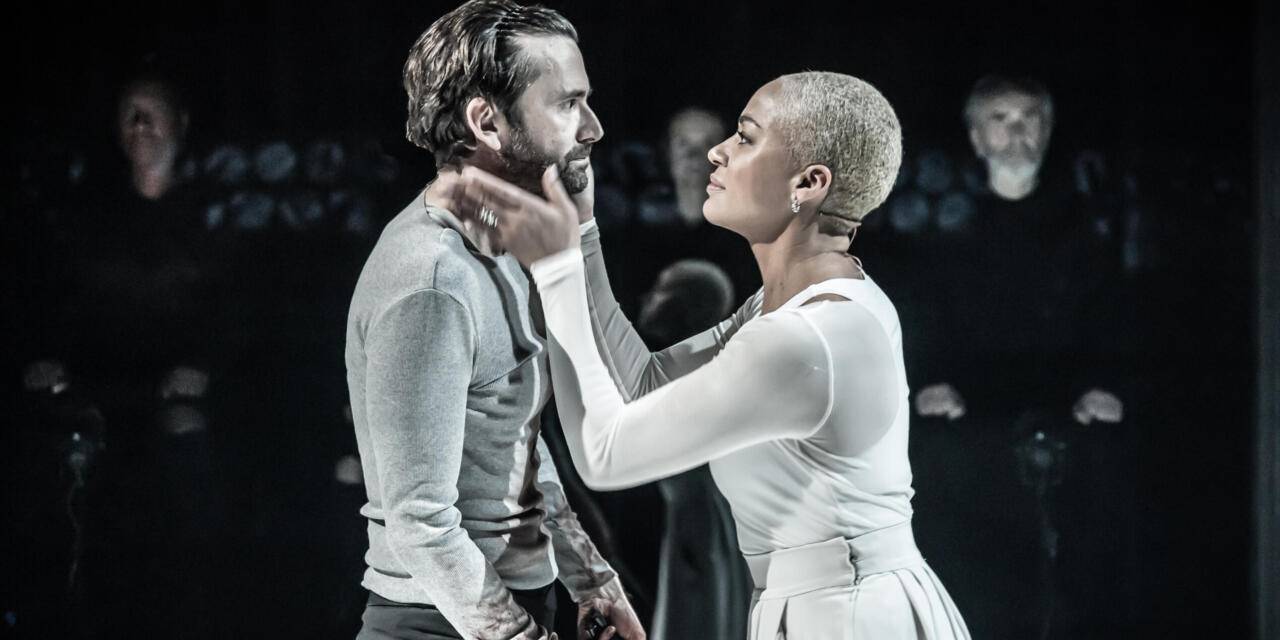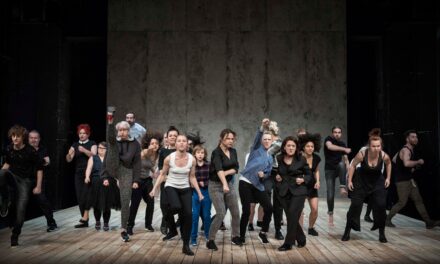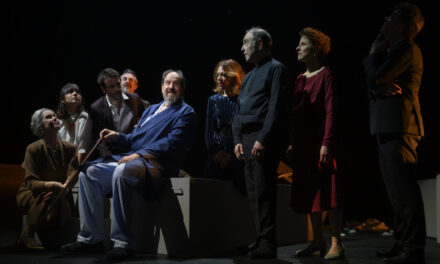How to render Macbeth anew—and how to do it well? It’s a question that has undoubtedly preoccupied countless directors, actors, and designers over the centuries. And it’s a question that has recently elicited an assured and compelling answer—certainly one of many—in Max Webster’s staging of the play at London’s Donmar Warehouse. As if the production’s casting of famed actors David Tennant and Cush Jumbo as the Macbeths weren’t enough to stir critical buzz, its central deployment of binaural stereo paves the way to a unique and well-executed re-envisioning of Shakespeare’s tragedy.
There are many aspects to commend in Webster’s resonantly stark Macbeth, but nearly all of them gain their sustained force from their interaction with the production’s aural intimacy and layering. Through headphones worn by each member of the audience for the duration of the performance, the auditory life on stage becomes invasive, granular, and haunting. It’s not just a matter of hearing the actors more clearly. Rather, sound designer Gareth Fry often brilliantly presents us with a 3D soundscape that exploits the various resources of the medium, including overlapping sound effects, changing volumes, and subterranean music. Many of Shakespeare’s familiar lines acquire new vibrancy when whispered or delivered inwardly, and the production’s decision not to show the Weird Sisters in their early scenes—but to have them mutter their premonitions into our ears in creeping, chilling ways—demonstrates a thoughtful engagement with the play’s, and Macbeth’s, questioning of reality and delusion.
This sonic immersion, of course, could have fallen flat if the cast weren’t able to deliver performances attuned to it, especially on the Donmar’s relatively small stage. But that’s far from the case here, for Tennant is terrifically fresh in his take on the leading part, conveying Macbeth’s fluctuating resolve with a piercing sense of transparency. So much so that it’s possible to catch glimpses of Hamlet in his final soliloquies, before he suggestively armors himself with a see-through posture of brazen confidence. As Lady Macbeth, Jumbo, too, presents a supremely calibrated performance, her internal journey both lucid and complex, and her character clearly tied to a prehistory of motherhood. There is a remarkable moment in her sleepwalking scene, for example, where she imagines herself to be holding the hand of a child, asking him to go “to bed.”
Attired in black and grey kilts (à la Thom Browne), the supporting cast displays engaging and finely pitched performances as well: Cal Macanich is a grounded and affectionate Banquo, and Noof Ousellam as Macduff unleashes his rage with care. Rona Morison’s Lady Macduff bristles with tender composure, while Benny Young impresses as both King Duncan and the Doctor. Several key moments are eloquently underscored by live Gaelic music, performed by singer Kathleen MacInnes and musicians Brian James O’Sullivan and Alasdair Macrae (also the composer).
Rosanna Vize’s minimalist design effectively bifurcates the action between a white platform, which also doubles as a big table, and an elevated glass box in which the ensemble is often lined up in chairs, as if serving as a transitional chorus. Bruno Poet’s lighting makes brilliant use of chiaroscuro, but not without plunging us into a red-tinged world during Macbeth’s second encounter with the witches, where Shelley Maxwell’s movement direction externalizes the supernatural apparitions with a grotesquely fluid choreography.
Perhaps the only thing to fault here is the Porter’s unduly contemporized speech, which can’t help but remain at odds with Webster’s otherwise clear-cut, fierce vision of Shakespeare’s succinct tragedy. Through its aural dramaturgy and riveting performances, this is, ultimately, a Macbeth that succeeds in unlocking new dimensions to the text. We simply can’t close our ears to its potent despair.
This post was written by the author in their personal capacity.The opinions expressed in this article are the author’s own and do not reflect the view of The Theatre Times, their staff or collaborators.
This post was written by Mert Dilek.
The views expressed here belong to the author and do not necessarily reflect our views and opinions.

















